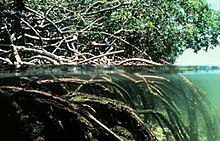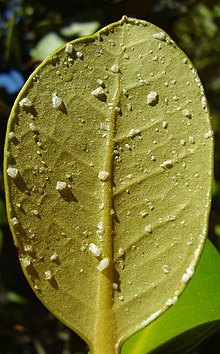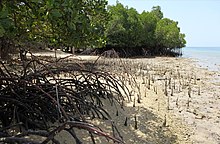Bonjuor
In this my article I wrote something about mangrove trees, date 16 to 17 May 2011 Gitj Easter program conducted in 1000 with the planting of mangrove trees on the northern coast of Java, exactly in Tawangrejorejo beach because this region is very severe abrasion, so we conducted this program to save the environment for the future of our earth. God has created us as perfect beings and we should have respect and care for God's creation . Let's see ;-D
Mangrove
Mangroves are various kinds of trees up to medium height and shrubs that grow in saline coastal sediment habitats in the tropics and subtropics – mainly between latitudes 25° N and 25° S. Such bosks are also part of the mangrove forest biome. The saline conditions tolerated by various species range from brackish water, through pure seawater (30 to 40 ppt), to water concentrated by evaporation to over twice the salinity of ocean seawater (up to 90 ppt).
There are many species of trees and shrubs adapted to saline conditions. Not all are closely related, and the term "mangrove" may be used for all of them, or more narrowly only for the mangrove family of plants, the Rhizophoraceae, or even more specifically just for mangrove trees of the genus Rhizophora.
Mangroves form a distinct characteristic saline woodland or shrubland habitat, called mangrove swamp, mangrove forest, mangrove or mangal. Mangals are found in depositional coastal environments, where fine sediments (often with high organic content) collect in areas protected from high-energy wave action. Mangroves dominate three quarters of tropical coastlines.
Ecology
Mangroves are found in tropical and subtropical tidal areas. Areas where mangals occur include estuaries and marine shorelines.
The intertidal existence to which these trees are adapted repesents the major limitation to the number of species able to thrive in their habitat. High tide brings in salt water, and when the tide recedes, solar evaporation of the seawater in the soil leads to further increases in salinity. The return of tide can flush out these soils, bringing them back to salinity levels comparable to that of seawater. At low tide, organisms are also exposed to increases in temperature and desiccation, and are then cooled and flooded by the tide. Thus, in order for a plant to survive in this environment, it must tolerate broad ranges of salinity, temperature, and moisture, as well as a number of other key environmental factors. It is unsurprising, perhaps, that only a select few species make up the mangrove tree community.About 110 species are considered mangroves. However, a given mangrove typically features only a small number of tree species. It is not uncommon for a mangrove forest in the Caribbean to feature only three or four tree species. For comparison, the tropical rainforest biome contains thousands of tree species. That is not to say that mangrove forests lack diversity. Though the trees themselves are few in species, the ecosystem that these trees create provides a home for a great variety of other organisms.
Mangroves require a number of physiological adaptations to overcome the problems of anoxia, high salinity and frequent tidal inundation. Each species has its own solutions to these problems; this may be the primary reason why, on some shorelines, mangrove tree species show distinct zonation. Small environmental variations within a mangal may lead to greatly differing methods for coping with the environment. Therefore, the mix of species is partly determined by the tolerances of individual species to physical conditions, like tidal inundation and salinity, but may also be influenced by other factors such as predation of plant seedlings by crabs.
Once established, mangrove roots provide an oyster habitat and slow water flow, thereby enhancing sediment deposition in areas where it is already occurring. The fine, anoxic sediments under mangroves act as sinks for a variety of heavy (trace) metals which colloidal particles in the sediments scavenged from the water. Mangrove removal disturbs these underlying sediments, often creating problems of trace metal contamination of seawater and biota.
Mangroves protect coastal areas from erosion, storm surge (especially during hurricanes), and tsunamis.The mangroves' massive root systems are efficient at dissipating wave energy. Likewise, they slow down tidal water enough that its sediment is deposited as the tide comes in, leaving all except fine particles when the tide ebbs. In this way, mangroves build their own environment. Because of the uniqueness of mangrove ecosystems and the protection against erosion they provide, they are often the object of conservation programs, including national biodiversity action plans.
However, mangroves' protective value is sometimes overstated. Wave energy is typically low in areas where mangroves grow, so their effect on erosion can only be measured over long periods.Their capacity to limit high-energy wave erosion is limited to events such as storm surges and tsunamis. Erosion often occurs on the outer sides of bends in river channels that wind through mangroves, while new stands of mangroves are appearing on the inner sides where sediment is accruing.
The unique ecosystem found in the intricate mesh of mangrove roots offers a quiet marine region for young organisms. In areas where roots are permanently submerged, the organisms they host include algae, barnacles, oysters, sponges, and bryozoans, which all require a hard surface for anchoring while they filter feed. Shrimps and mud lobsters use the muddy bottoms as their home. Mangrove crabs mulch the mangrove leaves, adding nutritients to the mangal muds for other bottom feeders.In at least some cases, export of carbon fixed in mangroves is important in coastal food webs.
Mangrove plantations in Vietnam, Thailand, the Philippines and India host several commercially important species of fish and crustaceans. Despite restoration efforts, developers and others have removed over half of the world's mangroves in recent times.
Biology
Of the recognized 110 mangrove species, only about 54 species in 20 genera from 16 families constitute the "true mangroves", species that occur almost exclusively in mangrove habitats. Demonstrating convergent evolution, many of these species found similar solutions to the tropical conditions of variable salinity, tidal range (inundation), anaerobic soils and intense sunlight. Plant biodiversity is generally low in a given mangal This is especially true in higher latitudes and in the Americas. The greatest biodiversity occurs in the mangal of New Guinea, Indonesia and Malaysia.Adaptations to low oxygen
Red mangroves, which can survive in the most inundated areas, prop themselves above the water level with stilt roots and can then absorb air through pores in their bark (lenticels). Black mangroves live on higher ground and make many pneumatophores (specialised root-like structures which stick up out of the soil like straws for breathing) which are also covered in lenticels. These "breathing tubes" typically reach heights of up to thirty centimeters, and in some species, over three meters. There are four types of pneumatophore—stilt or prop type, snorkel or peg type, knee type, and ribbon or plank type. Knee and ribbon types may be combined with buttress roots at the base of the tree. The roots also contain wide aerenchyma to facilitate transport within the plant.Limiting salt intake
Red mangroves exclude salt by having significantly impermeable roots which are highly suberised, acting as an ultrafiltration mechanism to exclude sodium salts from the rest of the plant. Analysis of water inside mangroves has shown 90% to 97% of salt has been excluded at the roots. Salt which does accumulate in the shoot, concentrates in old leaves which the plant then sheds. Red mangroves can also store salt in cell vacuoles. As seen in the picture on the right, white (or grey) mangroves can secrete salts directly; they have two salt glands at each leaf base (co-relating with their name—they are covered in white salt crystals).Limiting water loss
Because of the limited fresh water available in salty intertidal soils, mangroves limit the amount of water they lose through their leaves. They can restrict the opening of their stomata (pores on the leaf surfaces, which exchange carbon dioxide gas and water vapour during photosynthesis). They also vary the orientation of their leaves to avoid the harsh midday sun and so reduce evaporation from the leaves. Anthony Calfo, a noted aquarium author, observed anecdotally a red mangrove in captivity only grows if its leaves are misted with fresh water several times a week, simulating the frequent tropical rainstorms.Nutrient uptakeThe biggest problem that mangroves face is nutrient uptake. Because the soil is perpetually waterlogged, there is little free oxygen. Anaerobic bacteria liberate nitrogen gas, soluble iron, inorganic phosphates, sulfides, and methane, which makes the soil much less nutritious and contributes to mangroves' pungent odor. Pnuematophores (aerial roots) allow mangroves to absorb gases directly from the atmosphere, and other nutrients such as iron, from the inhospitable soil. Mangroves store gases directly inside the roots, processing them even when the roots are submerged during high tide.
Increasing survival of offspring
In this harsh environment, mangroves have evolved a special mechanism to help their offspring survive. Mangrove seeds are buoyant and therefore suited to water dispersal. Unlike most plants, whose seeds germinate in soil, many mangroves (e.g. red mangrove) are viviparous, whose seeds germinate while still attached to the parent tree. Once germinated, the seedling grows either within the fruit (e.g. Aegialitis, Avicennia and Aegiceras), or out through the fruit (e.g. Rhizophora, Ceriops, Bruguiera and Nypa) to form a propagule (a ready-to-go seedling) which can produce its own food via photosynthesis. The mature propagule then drops into the water, which can transport it great distances. Propagules can survive desiccation and remain dormant for over a year before arriving in a suitable environment. Once a propagule is ready to root, its density changes so the elongated shape now floats vertically rather than horizontally. In this position, it is more likely to lodge in the mud and root. If it does not root, it can alter its density and drift again in search of more favorable conditions.Taxonomy
The following listing (modified from Tomlinson, 1986) gives the number of species of mangroves in each listed plant genus and family.Major components
| Family | Genus, number of species | Common name |
|---|---|---|
| Acanthaceae, Avicenniaceae or Verbenaceae (family allocation disputed) | Avicennia, 9 | Black mangrove |
| Combretaceae | Conocarpus, 1; Laguncularia, 11; Lumnitzera, 2 | Buttonwood, white mangrove |
| Arecaceae | Nypa, 1 | Mangrove palm |
| Rhizophoraceae | Bruguiera, 6; Ceriops, 2; Kandelia, 1; Rhizophora, 8 | Red mangrove |
| Lythraceae | Sonneratia, 5 | Mangrove apple |
Minor components
| Family | Genus, number of species | ||||||
|---|---|---|---|---|---|---|---|
| Acanthaceae | Acanthus, 1; Bravaisia, 2 | ||||||
| Bombacaceae | Camptostemon, 2 | ||||||
| Cyperaceae | Fimbristylis, 1 | ||||||
| Euphorbiaceae | Excoecaria, 2 | ||||||
| Lecythidaceae | Barringtonia, 6 | ||||||
| Lythraceae | Pemphis, 1 | ||||||
| Meliaceae | Xylocarpus, 2 | ||||||
| Myrsinaceae | Aegiceras, 2 | ||||||
| Myrtaceae | Osbornia, 1 | ||||||
| Pellicieraceae | Pelliciera, 1 | ||||||
| Plumbaginaceae | Aegialitis, 2 | ||||||
| Pteridaceae | Acrostichum, 3 | ||||||
| Rubiaceae | Scyphiphora, 1 | ||||||
| Sterculiaceae | Heritiera, 3 |































